The Guntur Municipal Corporation denies water contamination allegations, and states that water sample reports are still awaited.

Inside the ward of the Guntur Government Hospital where the 'diarrhea and vomiting' outbreak patients are treated. (Supplied)
At least one minor tribal girl has died and more than 70 other people have been admitted to a government hospital in Guntur in Andhra Pradesh since Friday, 9 February, with symptoms of diarrhoea and vomiting.
This sudden outbreak of cases is being mostly reported in Guntur city, with the families of the patients and Opposition parties claiming contamination of municipal water as the reason.
While the Guntur Municipal Corporation (GMC) has denied the allegations, adding that water samples have been sent for reports, it could be due to other reasons such as food poisoning at a party or consuming outside food from a common source.
South First found patients aged from two-half-year old to the elderly on a ground visit.
A 45-year-old man named M Venkateswara Rao was wandering around Guntur Government Hospital as he waited for the test reports of his 66-year-old mother, M Punnamma.
She had been suffering from sudden diarrhoea and vomiting since Friday, and he admitted her to the hospital as her condition worsened.
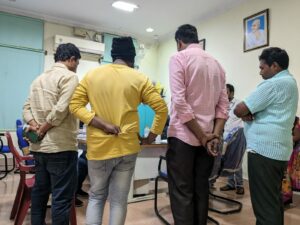
Bashid Shaik was waiting with a local political leader for the hospital superintendent, Dr. Y Kiran Kumar, to request extra caution for his two-and-a-half-year-old son Aayan. (South First)
Asked about the experts’ opinions and the reasons behind his mother’s illness, Venkateswara Rao told South First that the doctors were yet to provide a diagnosis.
As far as he was concerned, his mother had been drinking tap water supplied by the Guntur municipality, and he cited contamination of the water as a possible cause.
Rao mentioned that he only drinks mineral water, and so he hadn’t been affected.
On a similar note, a man named Bashid Shaik was waiting with a local political leader for hospital superintendent Dr Y Kiran Kumar.
Doctors had informed him that his two-and-a-half-year-old son Aayan’s condition was critical.
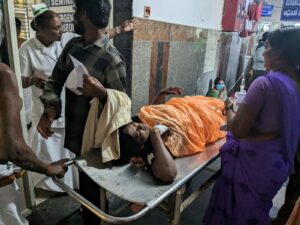
A 40-year-old woman, Kakarla Kamakshi, who just arrived at the hospital and is waiting for admission to a bed. (South First)
While Kumar was on rounds, another doctor in the office said the boy was in the ICU, and the doctors would try their best.
Bashid Shaik pleaded with the hospital management to save his child, who was running a fever of 104 degrees Fahrenheit, and was suffering from fits, symptoms of diarrhoea, and vomiting.
A 40-year-old woman named Kakarla Kamakshi, who just arrived at the hospital with her husband and was waiting for admission, said she had been drinking tap water for a long time.
However, the water hadn’t been good over the past few days, and she suspected that could be the cause of her diarrhoea and vomiting.
She said she was experiencing extreme fatigue.
Following the GMC announcement not to drink municipality water until the sample reports became available and the ongoing cleaning of water tanks at some places, the residents of Guntur have been arranging for drinking water through tanks from the GMC.
Bhogavarapu Lakshmi Kumpari, a 65-year-old woman, arrived at the centre of the street in Sharadha Colony (where the initial cases originated) accompanied by her neighbours.
She stated that queuing up for water from the vehicle tanks reminded her of the days from 30 years ago when she used to get water from vehicles for a ₹2 fee.
Having lived in the colony for the past 40 years, Kumari had not heard of cases of such illness but she said one death in the area alerted her.
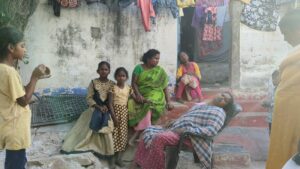
Padma’s mother, seated in a chair, is joined by her aunt and siblings as they mourn her loss. (South First)
Just a few metres from her residence in Sharada Colony, a 17-year-old girl named M Padma from the tribal community died on 9 February in the Guntur Government Hospital. Her post-mortem reports are yet to be received.
With the girl’s death, the small narrow street in Sharada Colony, Lane 25, is now filled with visitors from political parties.
Right at the entry of the street lanes, women from the neighbourhood immediately complained about irregularities in the water supply provided by the GMC.
Municipality water serves as the drinking water source for the residents of Guntur city. While some have paid for tap water connections to their houses, others have to fill water at the nearest common water point.
On the night of 7 February, Padma and her aunt Sajja Vijay Lakshmi went to a nearby place for water — just a few steps away from her house.
Sajja Vijaya Lakshmi told South First that they had been receiving water with a yellow colouration and small particles. Padma complained of diarrhoea and vomiting the day after drinking the water.
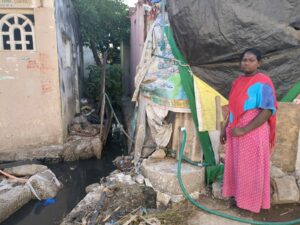
Sajja Vijaya Lakshmi showed the place where she and Padma filled water two days before Padma’s death. The surrounding area is filled with drainage water. (South First)
Lakshmi said on the morning of 8 February they went to a nearby place to consult a “Vanda rupayala doctor” (a registered medical practitioner or RMP who charges a ₹100 fee for consultation) and got medicine for Padma.
However, the girl didn’t experience any relief, and they took her to the government hospital at 5 am on 9 February as the symptoms increased in severity.
Asked why they didn’t approach a private or government hospital on 8 February instead of approaching an RMP, Lakshmi explained that Padma’s father had died in a government hospital two months ago, and she was afraid to go there.
However, they had to take her to a government hospital due to financial constraints and an inability to costly medicines.
Lakshmi recounted, “We took her to the hospital around 5 am, but no one attended to her until 11 am. Even as she had severe diarrhoea, there was no one from the hospital side to come and clean or even help us. Helpless, she later died in front of us. She could have been saved if government hospital doctors had provided treatment during the five-hour waiting time.”
In grief, Padma’s mother shared, “I couldn’t go as I can’t walk. She could have been saved. She is the only girl in the family earning wages by working in the Guntur Railway cleaning works sections, and now I have two young kids and three daughters to raise. So far, we have not received any assistance from the government.”
She added: “If we had money, we could have gone to a private hospital or received a political recommendation, but we are poor and had to suffer due to the system. It took the death of one of our own to bring attention to the long-pending issue of the GMC.”
Neighbouring women mourning the loss of Padma blamed the contamination of water. They said leakage due to road constructions in some places might have caused the contamination. They also said pipes running through drainage areas could have led to the contamination.
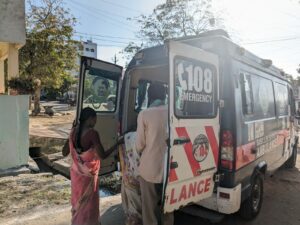
A woman from the Sharada Colony is being shifted in an ambulance to the primary health centre and then to the Government hospital due to the severity of her condition. (South First)
South First attempted to reach out to Dr Y Kiran Kumar, but he was attending rounds in the hospital and monitoring, making it impossible to reach him.
One of the in-charges at Guntur Government Hospital, who is overseeing the cases, shared details of the illness with South First, apparently with his permission.
The hospital functionary stated that the ward generally receives around two to five diarrhoea cases per day. Most are due to food poisoning, and treatment is provided with care, resulting in all patients being cured.
“Since 9 February, however, the hospital has seen a surge in cases with symptoms of diarrhoea and vomiting. So far, 75 such patients have been admitted. Around 30 people have recovered, and one has died. Most of them are improving with antibiotics and IV fluids,” said the functionary.
The functionary also said they initially thought the cause was water contamination, as per the complaints of the patients, and the pattern was that all were from the same area — Saradha Colony in Sangadigunta.
However, the cases gradually began to be reported from across the city, he noted. If treatment was delayed, the patient’s condition could get more serious, leading to faster acute kidney injury.
It was further stated that reports had been sent for examination and the results were to be received in two to three days, which would clarify the reason for the outbreak.
The functionary suggested that bacterial toxins could be the reason because not all family members who drank the water were affected in the contamination complaints; only those with comorbid conditions were affected.
Additionally, most cases were initially treated by RMPs, and the patients come to the government hospital after three days, leading to treatment of a more severe condition, said the functionary.
It was further stated, “While the sample reports sent to the microbiology department and the post-mortem report of the 17-year-old M Padma are yet to come, the whole picture points to secretory diarrhoea, which is similar to cholera.”
The GMC dispatched water tanks to the areas from where the cases were registered, and issued orders to clean the water tanks.
The residents in the affected areas are also being advised to drink only boiled water, and water tank vehicles have been sent for free drinking water distribution.
GMC Commissioner Keerthi Chekuri told South First that based on her understanding from ground visits, there was no truth in the allegations of water contamination.
She said, “If it was water contamination, it should affect everyone in the same family, leading to a higher case count. However, even though entire families consumed municipal water, only one or two individuals were affected.”
To address the concerns raised, the commissioner said that the GMC had sent water samples for testing as a precaution, and the results were yet to be received.
Meanwhile, the emergency health number 0863-2345103 has been issued, with local village or ward health secretaries and ASHA workers going door to door in the city to admit patients for treatment at the Urban Primary Healthcare Centre level, she added.
Meanwhile, Andhra Pradesh Health Minister Vidadala Rajini told reporters that a committee of five members had been set up to investigate the issue and that officials had been instructed to remain on high alert.

Jul 26, 2024

Jul 26, 2024

Jul 26, 2024

Jul 26, 2024

Jul 26, 2024

Jul 26, 2024